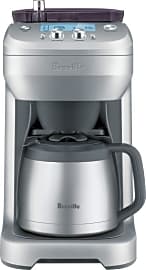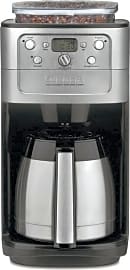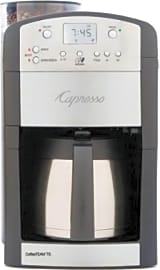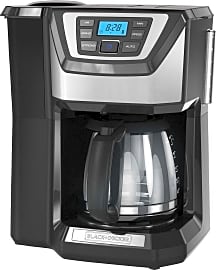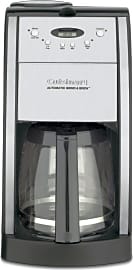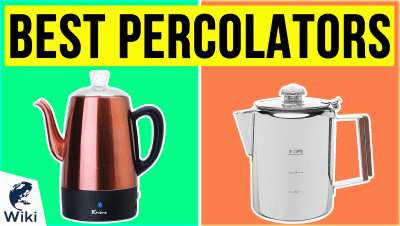The 7 Best Grind And Brews

This wiki has been updated 40 times since it was first published in February of 2016. Between making breakfast for the kids, getting dressed, and nudging everyone out the door, you don't always have time to create gourmet espresso. Luckily, these grinding coffeemakers will do all the work for you, so you can shower and get ready while they grind the beans and brew that piping hot cup or carafe of your favorite blend. Some even feature automatic timers, so you can sleep in a bit. When users buy our independently chosen editorial selections, we may earn commissions to help fund the Wiki.
Editor's Notes
July 29, 2021:
We made a small handful of important changes to the Wiki this time around. One was the removal of a few very similar models from less reliable manufacturers. We also upgraded to the Cuisinart DGB-900BC, which sports a durable and heat-retaining insulated thermal carafe. Possibly the most important change, though, was the addition of the De'Longhi ESAM3300 Magnifica. It's not their absolute most high-end model — you can spend thousands on a De'Longhi if you really want to — but it's reliable and especially easy to use, without any fancy digital controls to go haywire.
January 30, 2020:
We removed the Gourmia GCM4700 from this iteration of our ranking due to durability issues that more often than not resulted in leaks. In its place we found the Gevi Kitchen And Office and the Secura Automatic. The Gevi model is among the finest on the market for its ease of use and grind quality, and its wide carafe allows the entire unit to sit a little shorter than many others, fitting more comfortably in the space between the countertop and the kitchen cabinets. That Secura model is particularly nice for people who might want to start the day with a quick cup or two and then taper off until the next morning, as it's only designed to make a little bit of coffee at a time. Of course, that can be a big downside if company comes over looking for a pick-me-up, but you can keep a big percolator hidden away from such occasions.
Rise and Grind
When the bean is ground, that protective bubble bursts and the bean becomes stale in minutes.
Welcome to the future of coffee! Finally we have married two classic inventions to create a one stop shop for gourmet coffee making. I am referring to the grind and brew; which is a single machine that both grinds beans and brews coffee. It's the best of both worlds and it's extremely convenient for the on-the-go commuter who prefers homemade coffee to large chain operations.
Why is the grind feature included you might ask? Can't you just buy vacuum sealed pre-ground coffee and brew it with a traditional drip coffeemaker? Of course you can, but you will sacrifice freshness. After a bean is roasted, for up to two weeks the bean releases carbon dioxide, forming a shield that prevents the bean from becoming stale. When the bean is ground, that protective bubble bursts and the bean becomes stale in minutes.
This is why shrewd coffee makers vacuum seal the coffee to lock in freshness. However, after the bag is open, the pre-ground blend you bought will be stale after the first cup. The grind and brew solves this conundrum by offering to grind only the amount used in the cup today; preventing ground coffee to sit around and grow stale and lose its aroma.
Also, the grind feature allows for a level of customization. The settings permit you to chose from a fine grind to a course grind. Supposing you like weaker coffee, chose a courser grind and the result will be achieved because less flavor will be extracted for the grounds. Espresso drinkers and lovers of Turkish coffee can be satisfied by a very fine grind which highlights a bitter taste.
The machine will also keep the brew hot; as opposed to a french press or pot, which will dissipate heat. Lastly, some grind and brews will brew the coffee directly into a travel mug, making it ultra convenient with no clean up.
A Whole Host Of Features
The grind and brew is the new kid on the market, and it succeeds in convenience and adaptability over its competitors.
A great cup of coffee is the work of many parts coming together in a beautiful, caffeine-enhanced way. What places the grind and brew above other brewing methods is the grinder and the heating mechanism that keeps the coffee at optimal temperature.
Many consumers fear leaving unattended glass carafes will lead to burnt coffee.
The grind function might be the most important feature when choosing your machine. It will have either a blade mill or a burr grinder. The blade mill will be cheaper, but it produces more heat which can alter the taste of the coffee. Not to mention the beans will not be ground at a consistent size. A burr grinder is more slow and thorough because is accounts for proper uniform grain size; too large and the coffee won't be fully extracted, resulting in weaker coffee.
On the opposite end of the spectrum, most of these machines offer a level of programmability. Setting the coffee to grind and brew for you every morning at 8:00 is highly convenient. It can be your reality. Most machines will also have an auto shut off feature.
The coffee will be brewed into a carafe that is made of either glass or an insulated metal. The glass carafe is the traditional glass you see at diners. Many consumers fear leaving unattended glass carafes will lead to burnt coffee. The thermal cafe addresses this issue. It will insulate the hot coffee for hours without the use of a hot plate. Personally I feel that while the flavor is locked in with the thermal carafe, I prefer the extra hot temperature that only the glass carafe can offer.
If the primarily reason you chose to purchase a grind and brew is convenience and speed, the last thing you want is to be cleaning it out on a daily basis. Check with the model to see if a filter is needed. A filter can easily be disposed of and is simpler than cleaning the unit.
A Brief History of Brewing Coffee
Coffee is one of the oldest beverages enjoyed by the modern world. For years cultures roasted and brewed coffee beans simply by heating water over a pot and adding beans. Over the course of time, the process became refined.
The pot uses steam to brew and it is still the favorite method in Latin and South American countries.
The coffee percolator is one of the oldest methods and it was invented in 1885, before electricity. The process works by boiling water and using gravity to seep the grounds in the boiled water repeatedly.
The Moka pot, designed by Alredo Buletti, gained popularity in Italy in the 1930s. The pot uses steam to brew and it is still the favorite method in Latin and South American countries.
The electric drip coffeemaker was next and upset all the coffee methods previously. The way it works is cold water from a reservoir goes through a tube be to heated by a metal plate via an electric current. The hot water is then dripped over coffee grounds into a glass carafe below. The grind and brew operates in a similar fashion, and most see it as an advancement to the drip coffeemaker.
The grind and brew is the standard for coffee professionals and you deserve a professional brew.



